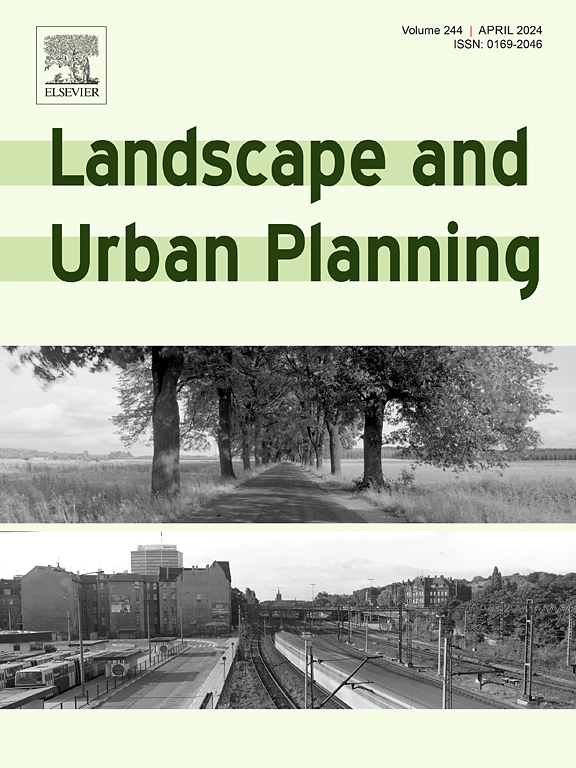通过全年数值模拟研究广州市城市绿地垂直结构对小气候的影响
IF 9.2
1区 环境科学与生态学
Q1 ECOLOGY
引用次数: 0
摘要
城市绿地(UGS)被认为是调节小气候的有效策略。垂直结构和规模都是影响地下水库小气候调节能力的关键因素。然而,在不同季节和热浪等极端天气条件下,UGS内垂直结构和大小的交叉效应以及能量和水汽传输过程对其小气候调节能力的影响仍未得到充分研究。在本研究中,我们建立了一个热环境模型,并进行了全年的数值模拟。结果表明,虽然UGS通常具有冷却效果,但这种效果并不总是一致的。例如,在土壤含水量低的时期,UGS可能会经历比居民区更高的气温。在UGS内,树木、灌木和土壤在小气候调节中发挥着不同的作用。树木主要通过遮阳减少辐射通量,而灌木和土壤则通过ET调节小气候。较大的地表地质系统总体上表现出更显著的降温效应,其大小和降温效率之间存在明显的阈值,在植被密集的地表地质系统中尤为明显。此外,UGS在热浪期间显示出更大的小气候调节能力。灌溉管理的实施可以进一步增强其调节小气候的潜力。这些发现表明,城市规划应优化UGS的设计和管理,包括垂直结构和灌溉,以增强冷却,特别是在极端高温下。本文章由计算机程序翻译,如有差异,请以英文原文为准。
Study on the effect of vertical structure of urban green spaces on microclimate in Guangzhou through a full year numerical simulation
Urban green spaces (UGS) are recognized as effective strategy to regulate microclimates. The vertical structure and size of UGS are both key factors influencing their microclimate regulation capacity. However, in different seasons and under extreme weather conditions such as heatwaves, the cross-effect of vertical structure and size, as well as the impact of energy and water vapor transfer processes within UGS on their microclimate regulation ability, remain largely underexplored. In this study, we developed a thermal environment model and conducted a full year numerical simulation. The results indicate that while UGS generally have a cooling effect, this effect is not always consistent. For instance, during periods of low soil water content, UGS may experience higher air temperatures than residential areas. Within UGS, trees, shrubs, and soils play distinct roles in microclimate regulation. Trees primarily reduce radiation flux through shading, while shrubs and soils contribute to microclimate regulation through ET. Larger UGS generally exhibit a more significant cooling effect, with a clear threshold between size and cooling efficiency, particularly evident in densely vegetated UGS. Furthermore, UGS demonstrates a greater capacity for microclimate regulation during heatwaves. The implementation of irrigation management could further enhance their potential for microclimate regulation. These findings suggest that UGS design and management, including vertical structure and irrigation, should be optimized in urban planning to enhance cooling, especially during extreme heat.
求助全文
通过发布文献求助,成功后即可免费获取论文全文。
去求助
来源期刊

Landscape and Urban Planning
环境科学-生态学
CiteScore
15.20
自引率
6.60%
发文量
232
审稿时长
6 months
期刊介绍:
Landscape and Urban Planning is an international journal that aims to enhance our understanding of landscapes and promote sustainable solutions for landscape change. The journal focuses on landscapes as complex social-ecological systems that encompass various spatial and temporal dimensions. These landscapes possess aesthetic, natural, and cultural qualities that are valued by individuals in different ways, leading to actions that alter the landscape. With increasing urbanization and the need for ecological and cultural sensitivity at various scales, a multidisciplinary approach is necessary to comprehend and align social and ecological values for landscape sustainability. The journal believes that combining landscape science with planning and design can yield positive outcomes for both people and nature.
 求助内容:
求助内容: 应助结果提醒方式:
应助结果提醒方式:


